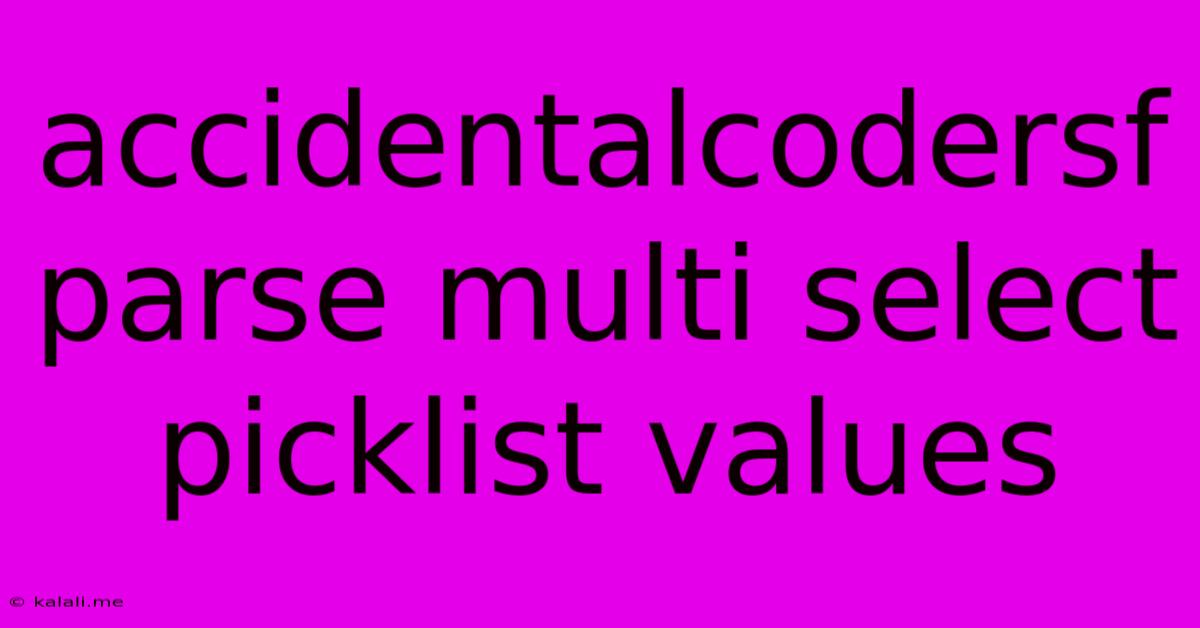Accidentalcodersf Parse Multi Select Picklist Values
Kalali
Jun 07, 2025 · 3 min read

Table of Contents
Parsing Multi-Select Picklist Values in Accidental Coders SF
This article will guide you through parsing multi-select picklist values, a common challenge when working with Salesforce data using Accidental Coders SF (or any other Salesforce integration). Understanding how to handle these values is crucial for accurate data processing and reporting. We'll explore different approaches, focusing on clarity and efficiency. This is particularly useful for developers working with Apex, Visualforce, or external integrations.
What are Multi-Select Picklists?
In Salesforce, multi-select picklists allow users to select multiple values from a predefined list. Unlike single-select picklists, these store values as a semi-colon separated string. For example, a picklist field named "Interests" might contain values like "Hiking;Camping;Photography". This string format necessitates parsing to extract individual selected options.
Common Challenges and Solutions
The primary challenge lies in converting this semicolon-separated string into a usable data structure, such as a list or set, for further processing. Here are several approaches:
1. Using String Manipulation in Apex
This is a straightforward approach, especially for simple scenarios. We leverage Apex's built-in string functions.
String multiSelectValue = 'Hiking;Camping;Photography';
List selectedValues = multiSelectValue.split(';');
//selectedValues now contains a list of individual values: ['Hiking', 'Camping', 'Photography']
System.debug(selectedValues);
This code snippet uses the split(';') method to break the string into individual elements using the semicolon as a delimiter. This is efficient for smaller datasets.
2. Handling Null or Empty Values
Robust code should account for scenarios where the multi-select picklist is empty or null.
String multiSelectValue = 'Hiking;Camping;Photography';
List selectedValues = new List();
if (multiSelectValue != null) {
selectedValues = multiSelectValue.split(';');
}
This improved version checks for null values before attempting to split the string, preventing null pointer exceptions.
3. Using Sets for Unique Values
If you only need unique selected values, using a Set is more efficient than a List. Sets automatically eliminate duplicates.
String multiSelectValue = 'Hiking;Camping;Photography;Hiking'; //Note the duplicate 'Hiking'
Set uniqueSelectedValues = new Set(multiSelectValue.split(';'));
//uniqueSelectedValues now contains only unique values: {'Hiking', 'Camping', 'Photography'}
System.debug(uniqueSelectedValues);
This approach ensures you work only with distinct selected options, streamlining further processing.
4. Advanced Scenarios and Considerations
For complex scenarios involving large datasets or intricate logic, consider these points:
- Error Handling: Implement robust error handling to manage unexpected input formats or data inconsistencies.
- Performance Optimization: For very large datasets, explore alternative approaches, such as using SOQL queries with optimized filters and aggregations.
- External Integrations: When integrating with external systems, ensure data transformation aligns with the target system's requirements. Consider using appropriate data mapping techniques.
Conclusion
Parsing multi-select picklist values in Salesforce is a common task that requires careful consideration. By understanding the various methods and best practices outlined in this article, you can efficiently and reliably process these values in your Accidental Coders SF projects, improving data accuracy and application functionality. Remember to always prioritize clean, well-documented, and maintainable code. Choosing the right approach depends on the specific context of your application and the volume of data you're handling. Always test your code thoroughly!
Latest Posts
Latest Posts
-
Can You Put A Teflon Pan In The Oven
Jun 07, 2025
-
Word For Beginners Whith Expensive Stuff
Jun 07, 2025
-
Screen Flashes Black Coming In And Out Of Water Minecraft
Jun 07, 2025
-
Spade Bits Drill Hole In The Desk
Jun 07, 2025
-
Contact Us When Your Footer Has Your Information
Jun 07, 2025
Related Post
Thank you for visiting our website which covers about Accidentalcodersf Parse Multi Select Picklist Values . We hope the information provided has been useful to you. Feel free to contact us if you have any questions or need further assistance. See you next time and don't miss to bookmark.